Estimated reading time: 22 minutes
A composting toilet uses composting action to decompose human waste, reduce odor, and make it biologically safe in an enclosed environment. It can also be used to compost kitchen waste and any other vegetable or animal waste. But the word compost leads some people to believe it’s safer than it actually is.
Don’t Assume You Can Just Dump it In the Garden
Any animal waste, whether it’s from a dog, cat, or human is rife with bacteria and microbes from e-coli to salmonella that are dangerous if tossed into a vegetable garden, even after some degree of composting.
It takes time to bio-degrade and make some waste products safe. The recommended minimum is one full year of composting in a dedicated compost heap for any human waste.
Want to save this post for later? Click Here to Pin It On Pinterest!
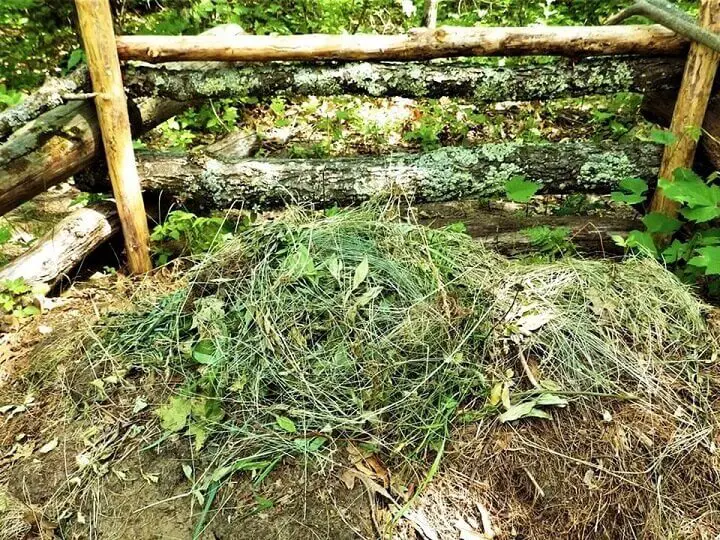
That time is measured from the last deposit of compost from the toilet. As a result, the best setup is a dual compost heap where new deposits can be made over the course of a year while the first compost heap continues to decompose the waste for 12 months.
Some people set up 3 compost piles so they can harvest from one while the second is composting for a year and the third can be used for new deposits.
The fundamental reason is that manure from herbivores like cattle, horses, and other animals that only consume grass and vegetable matter are a different story. Manure from carnivores and omnivores like humans are different and complicated, although all manure contains some degree of microbes and bacteria.
Why Would You Need a Composting Toilet?
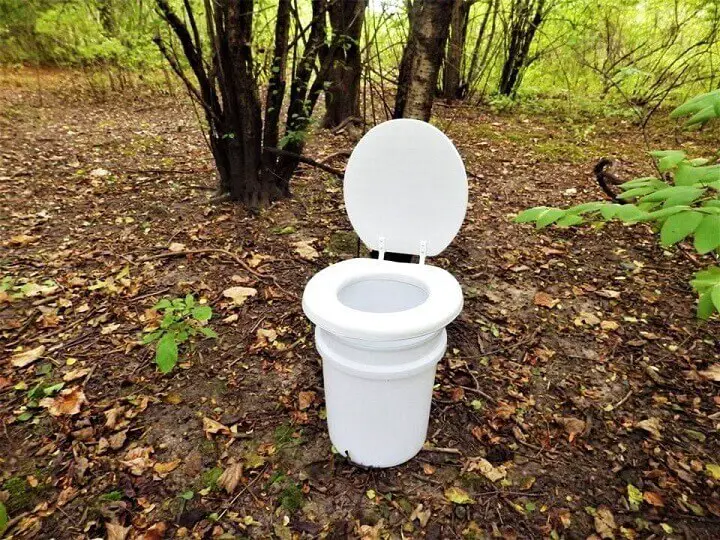
One of the obvious reasons is for someone living off grid for short periods of time. Anyone off grid for longer periods would probably have an outhouse, but if you’re only off grid for a while, a composting toilet is both small and easy to manage.
Another benefit, even if you have an outhouse, is avoiding that long trek to the outhouse in the middle of the night in winter. A composting toilet can be kept indoors and, with proper maintenance and occasional removal of material, will be odor free.
More extreme reasons for a composting toilet range from power outages resulting in a loss of water from a well, to septic system problems. Some RV’s and boats have composting toilets, and many remote outbuildings like barns, sheds, and tiny homes often use composting toilets.
Then again, some people turn to a composting toilet to reduce water usage. A composting toilet uses no water, unlike a traditional toilet which uses 1 to 3 gallons per flush, and can save on the growing costs of water bills. If done properly, it can also add nutrients back to garden soils.
What’s the Concept?
A composting toilet provides an alternative to flush toilets by disposing of human waste while minimizing the use of water. By mixing the waste with sawdust, peat moss, coconut coir, or other plant material, the toilet eliminates odor through an aerobic processing system.
In a pinch you could use compost from a regular compost heap to start the process, but avoid using compost from a heap that has already been used for human waste.
Here are some of the typically used materials for composting toilets:
Sawdust
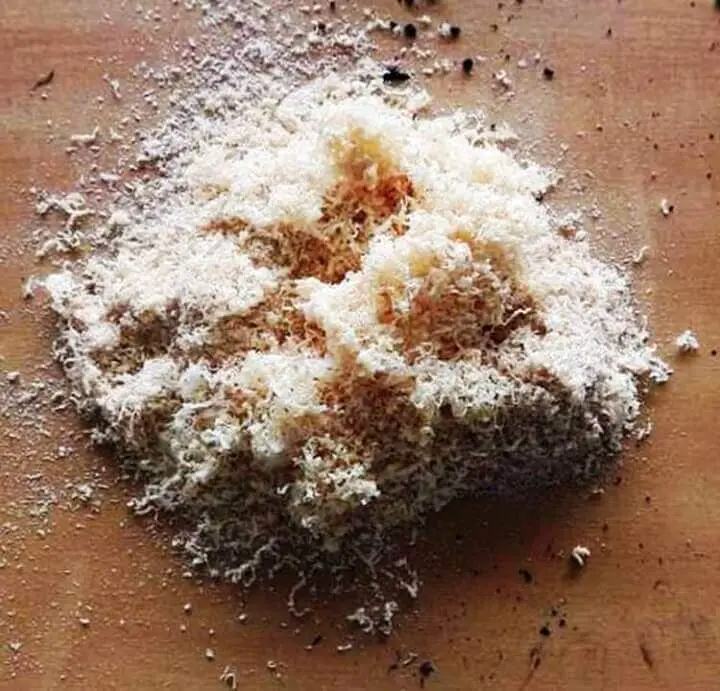
For many people, sawdust is the preferred material or substrate for composting toilets. The good news is that if you do any timber cutting or carpentry, you’ll probably have a regular supply. If you don’t do a lot of work with wood resulting in sawdust, you’ll need to consider some other options.
Peat Moss
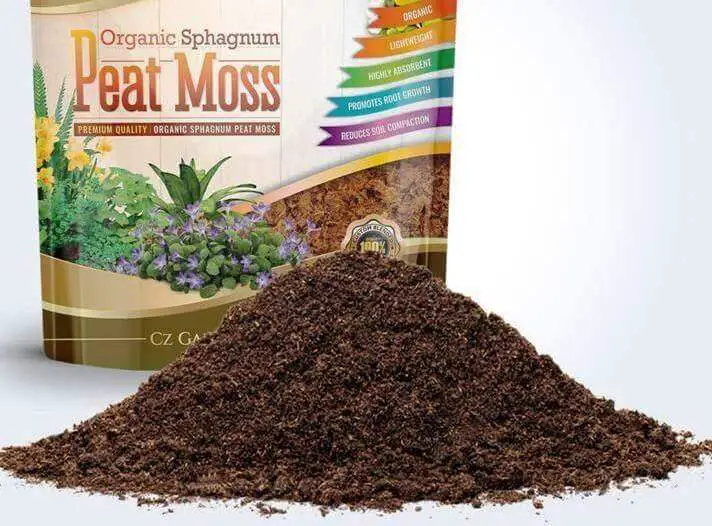
Peat moss is another popular option, although you’ll probably have to buy it at a garden center or online. If you live in an area where peat moss occurs naturally, consider yourself lucky. Most of us don’t live in tundra landscapes where peat moss is prevalent.
Compost from a Clean Heap
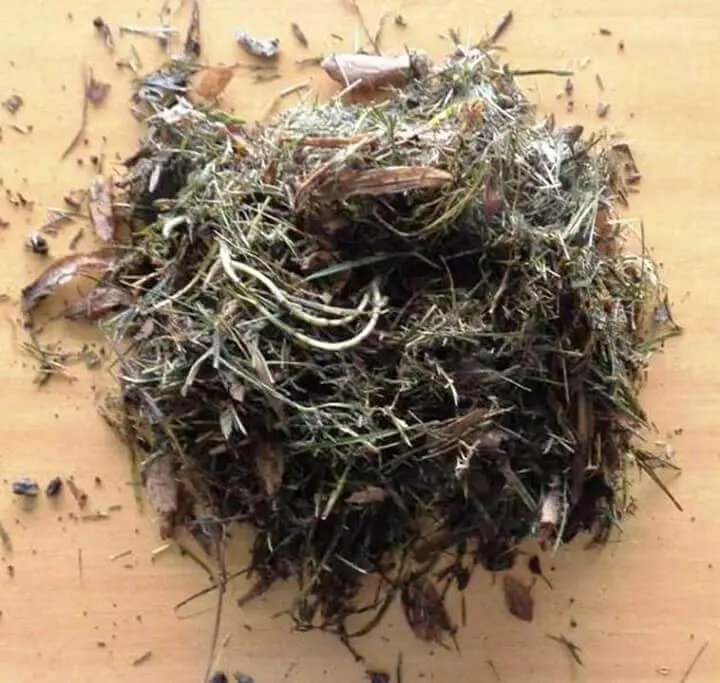
This is an easy option if you have a traditional compost heap for a yard or garden. It should not be from a compost heap where you are composting human waste.
Use the natural organics from plants in your traditional compost heap and chances are the already started composting action will accelerate the activity in your composting toilet.
Dirt
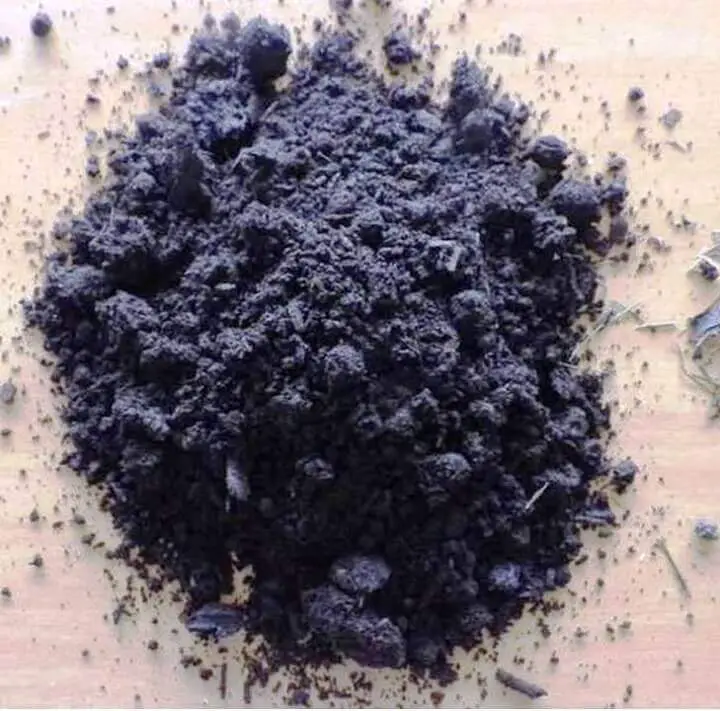
Plain old dirt can work and is usually loaded with the aerobic bacteria that activates composting.
Wood Ash
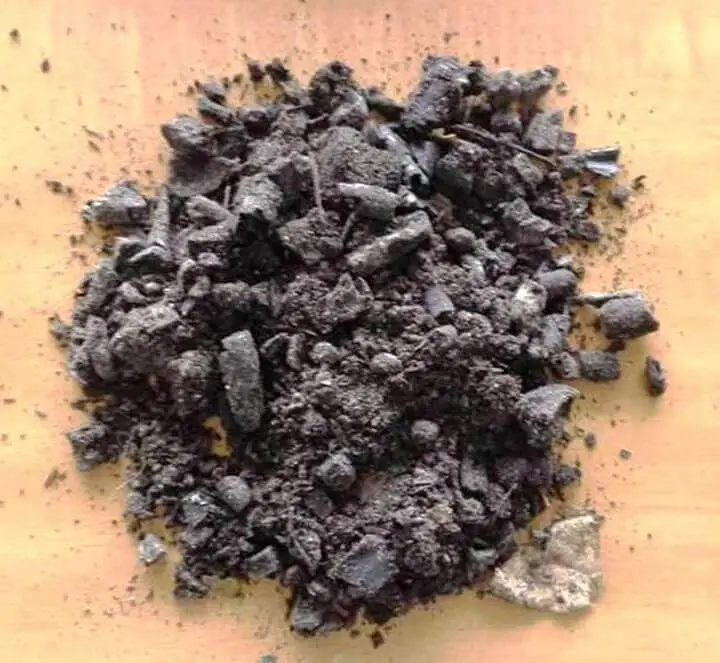
Wood ash alone may not work as well as some other substrates, but the addition of wood ash and the charcoal that often accompanies it will sweeten the mix and make it more alkaline as a result of the lye extracts from the ash. Alkaline properties accelerate composting, and the charcoal can minimize odors to some degree.
Coconut Fiber (Coir)
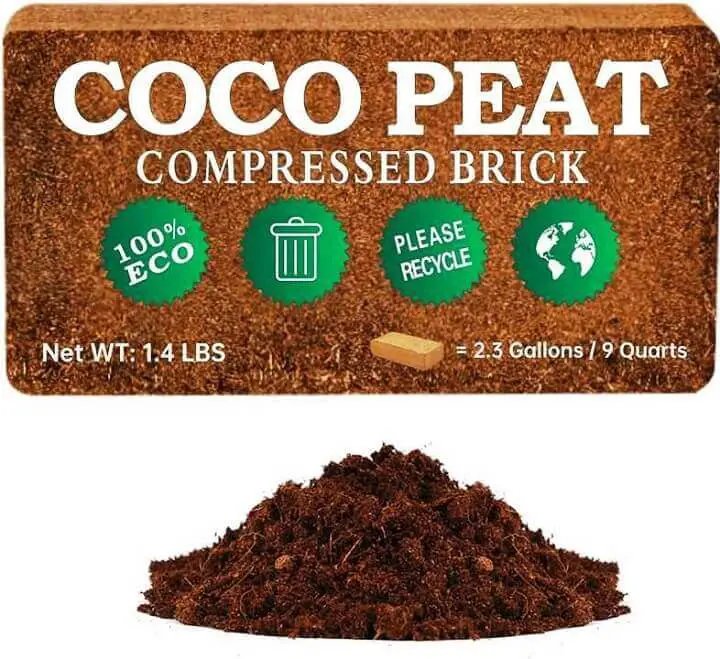
Coconut peat or “coir” is another excellent substrate for a composting toilet, but once again, most of us would have to buy it at a garden center or online. It often comes in compressed bricks that need to be slightly rehydrated to break the brick apart and then allowed to lightly dry before use.
It’s a lot of work, but it’s an excellent substrate for a composting toilet, especially if you live on a tropical island loaded with coconuts.
Kitchen Waste

Kitchen waste from vegetable trimmings often find their way into traditional compost heaps, but a proportion can also be used in a composting toilet if mixed with another dry substrate in a 50/50 mix.
There are other options including:
- Dry leaves
- Corn husks
- Grass clippings (preferably very dry)
Some people also add a small amount of powdered or pelletized lime to sweeten the mix and accelerate composting. That depends on your usage. If you only empty your composting toilet every month or two, it helps to add a little lime if the contents begin to get a bit ripe or if frequent use overwhelms the composting action.
The key is to experiment until you find the best composting material for your usage. What’s critical is that the compost be as dry as possible, although kitchen scraps will always retain a bit of moisture, so make sure you combine it with dry materials.
When to Empty Your Compost Toilet
Generally, two people with full-time usage will require emptying approximately every 3 weeks; additional people will shorten the time. If using just on weekends with 2 people, that can extend to 2 months or more.
Just a couple of days of non-use extends the period of time. If you ever notice bad odors that just won’t quit, it’s time to empty the bucket.
Some people always keep two buckets on hand. One is actively working in the composting toilet while another one is rinsed, clean, and standing by. This makes it easier to dump one, clean it out, and let it dry while the other one is in use.
What Are the Disadvantages of a Composting Toilet?
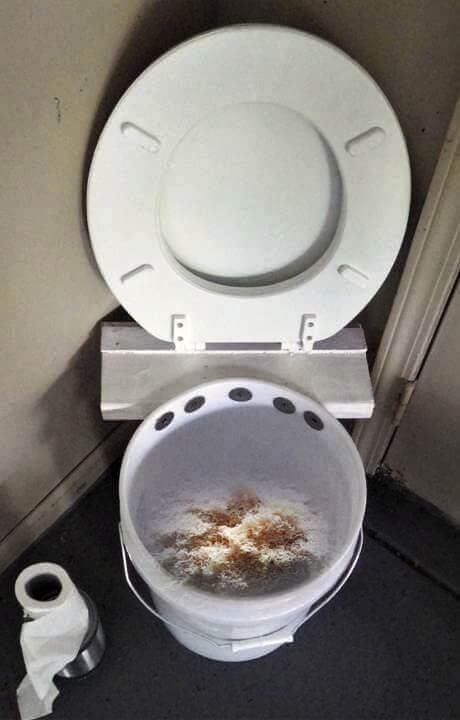
To put it simply, they’re somewhat high maintenance. It’s not as simple as a quick flush, and it requires not only removal of bucket for deposit into the compost heap, but the continual collection and storage of sawdust or other composting material added to the bucket before and after each use.
When using a self-contained compost toilet unattached to a system, you’ll have to manually remove the end product (which could prove to be an unsavory task, to say the least).
Disadvantages
- Manual removal of waste.
- Not necessarily aesthetically pleasing.
- Smaller units may have limited capacity for accepting larger amounts of waste.
- Some purchased systems made by a manufacturer require a power source.
- Improperly installed and maintained systems can produce odors and unprocessed material.
Perhaps the biggest disadvantage of composting toilets is the increased level of maintenance and manual upkeep required. Slacking in your maintenance routine can lead to not only terrible odors but horrible messes and health hazards.
The Urine Challenge
If the compost gets too wet from urine, anaerobic bacteria will start to grow instead of the aerobic ones you want. The anaerobic bacteria will make the compost smell nasty, and it will not break down into safe fertilizer. Nitrogen in urine also hinders the composting process.
That’s why it’s so important to keep urine out of your DIY composting toilet as much as possible. There are two ways to do this:
1. Urine diverting device. This goes below the seat of the composting toilet. It funnels urine into a separate collection chamber. You can simply dump the urine in your yard since it is sanitary.
2. Separate urine bucket. This is the easiest and most direct way, but it can be annoying for ladies to have to switch from one bucket to the other. Also, if small children will be using the composting toilet, they might not be able to control their movements and could end up urinating in the solids bucket.
You can buy urine diverters on Amazon to go under the toilet seat, though it’s a little expensive.
You can also make your own out of funnels or pieces of plastic with tubes connected to them to reroute the urine out of the bucket into a container. Here’s a link to instructions on how to do it.
If urine finds its way into the bucket and an odor results, the only solution is to dump and rinse the bucket.
Then again, there are some toilet composters who don’t feel urine in the bucket is any problem and haven’t noticed any odors. The final proof will be your own experience, but scientifically it makes sense to try and keep the urine separate from the compost in the toilet.
Is a Composting Toilet Worth the Hassle?
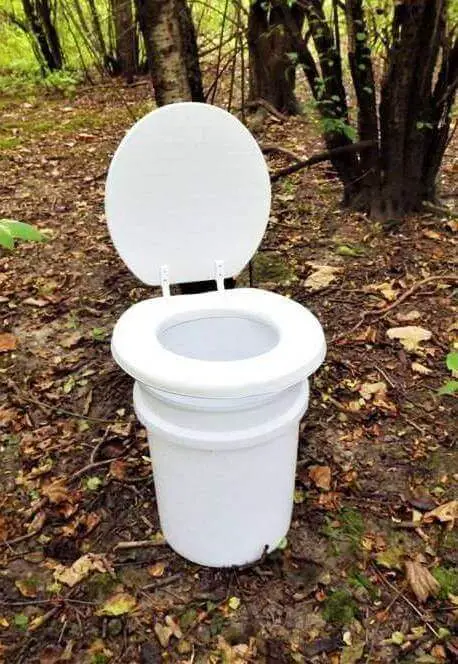
That depends a lot on where you live and your situation. Most people who use composting toilets live remotely or on the road, but in emergencies or after a disaster, anyone may find the need to live this way.
Benefits
- Promotes composting of kitchen waste as well as bathroom waste.
- Reduces dependence on conventional plumbing and sewage system.
- Reduces overall water use.
- Decreases household maintenance costs related to plumbing and sewer or septic systems.
- Reduces marine pollution (from toilets on boats).
- Ease of property planning (when space is limited or easy access to water is unavailable).
- Flexibility in land development (no septic system).
Although we have laid out many factors to consider and regulate, operating a composting toilet doesn't require any special training. In fact, there are so many advantages to a composting toilet system that, for most people, they outweigh the hassle.
In addition to composting the human waste in your household, the system allows you to recycle and compost anything you would normally put in your kitchen sink disposal (food scraps, etc.), thus cutting down on overall household waste.
Onsite composting systems are far easier to manage than conventional plumbing systems, and they allow you to avoid issues that most water-borne systems cause.
Unlike conventional sewage systems, which require advanced planning during a property’s development, composting toilet systems may be incorporated whenever they’re needed.
Why Not Just Buy a Composting Toilet?

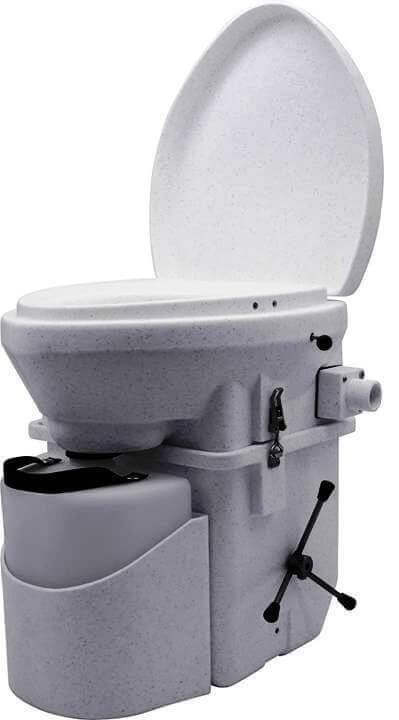
You certainly can but they’re a bit expensive. If you are worried about the cosmetics of a composting toilet, many of the models available on Amazon have a sleek appearance compared to what we might improvise ourselves.
That notwithstanding, they also require regular maintenance and emptying, so while a purchased composting toilet may be more aesthetically pleasing, their operation and maintenance is fundamentally the same.
How to Build the Right Composting Toilet
There are a few possibilities for a composting toilet. All are easy to construct. Which approach you take and how ambitious you choose to get depends a lot on the location of the toilet and the frequency of use.
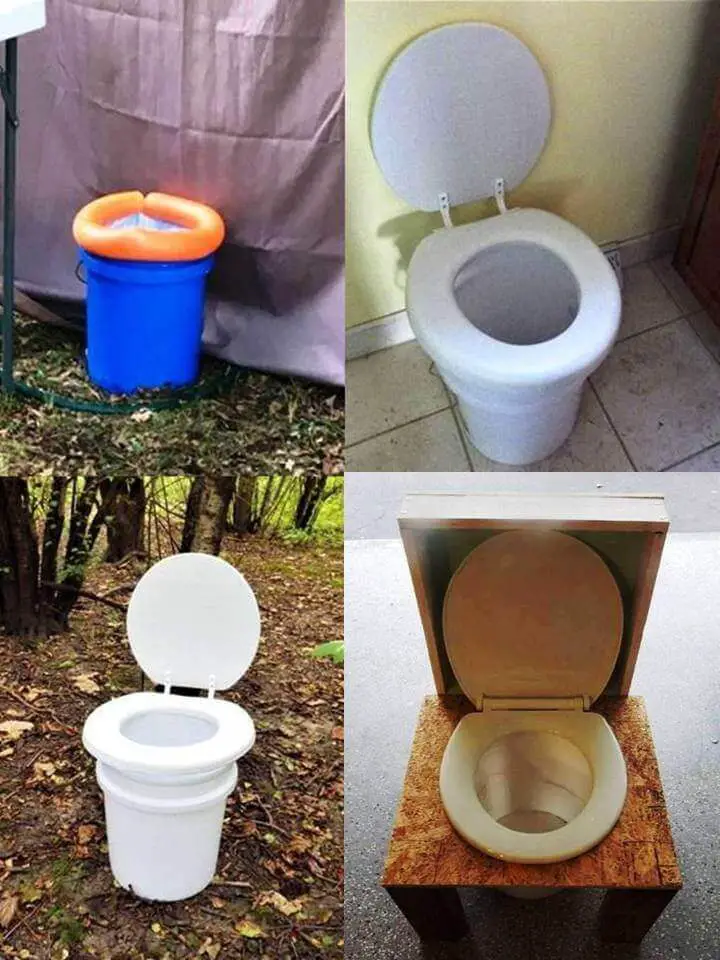
If you are using a composting toilet on a temporary basis, you can keep it simple. If you intend to use a composting toilet long-term on a regular basis, you’ll probably want to get a little more ambitious.
Here are 3 possibilities from basic to ambitious:
1. A Basic Outdoor Composting Toilet

For this example all you need is a 5-gallon bucket and a tube of foam from a swimming pool noodle in addition to adding your compost substrate of choice.
This is a good option for temporary, emergency use, or for a fixed camping location or other remote situations.
- 5-gallon bucket
- A lid or improvised cover
- Swimming noodle
- Compost: Sawdust/dirt/or peat moss

Assembly:
- Cut a straight line down the center of the noodle to the hollow core.
- Insert the noodle over the rim of the bucket and continue to push it down on the rim around the circumference of the bucket.
- When you reach the other end of the rim at the top of the bucket carefully cut the noodle and push it down all around until firmly attached to the rim.
- Fill the bucket ¼ full with sawdust or peat moss or other compostable material.
- Toss some more of the compostable material into the bucket after each use.
- Cover the bucket with a board or lid after use.
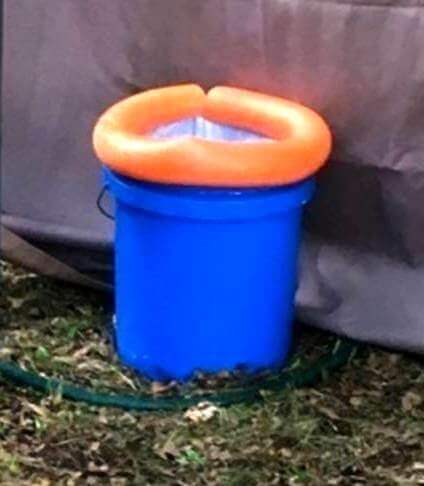
2. Compost Toilet with Lid for Outbuildings and Garage
(There’s an extended article about constructing this type of portable toilet. The directions indicate the use of a plastic bag insert, but skip the plastic bag and just add compost material directly to the bucket.)
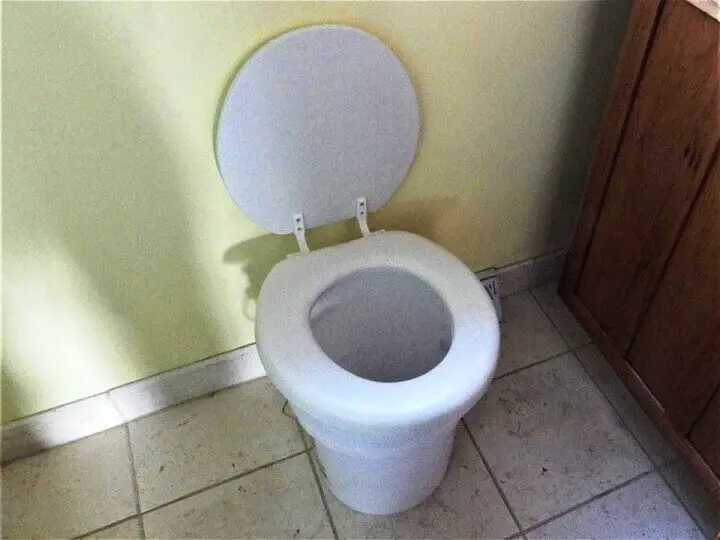
This is a step up from the basic outdoor compost toilet because it offers the real comfort of a toilet seat. It’s also portable so it can be easily moved from location to location, and it makes it easy to transport and dump the compost into the compost heap.
It’s a good choice for a remote barn, shed or other location where bathroom facilities are unavailable or limited.
- Toilet seat
- 5-gallon bucket
- Composting material consisting of either sawdust, topsoil, green composter wood ashes or a combination
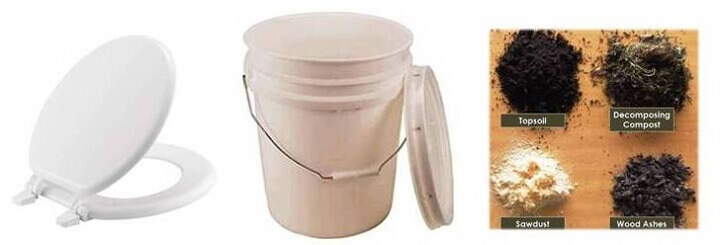
Assembly:
- Attach the toilet seat to the lid of the bucket so the seat easily opens and closes.
- Fill the bucket with compostable material which could include sawdust, soil, green and decomposing compost. Use wood ashes as an added component to moderate odors.

3. Compost Toilet for In-Home Use
This is the most complex compost toilet we’ll cover. It features a wooden cabinet structure but still uses a 5-gallon bucket as the receptacle. The bucket is slid under the toilet seat for use and can be easily pulled out to be emptied into the compost heap.
A lid is placed over the bucket when not in use to keep down odors as well. This is the best choice for a permanent or semi-permanent location in an indoor living environment.

Another feature is a bucket next to the toilet to hold additional compost material. This bucket is a feature you’ll want regardless of the type of composting toilet you construct. It’s a necessary addition so that sawdust or other compostable material can be scooped into the compost toilet after each use.
Finally, you can either buy a urine diverter, make one using this link with instructions or simply place a small coffee can or plastic bowl in the front of the bucket to intercept any urine.
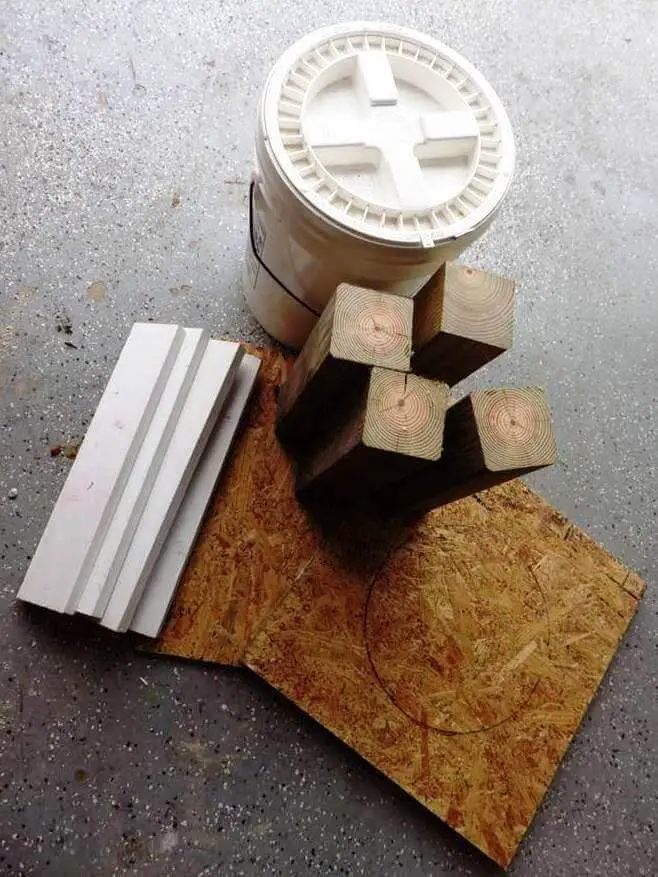
- A plywood board about 2-foot square with a hole cut in the middle over the bucket. The platform also allows you to bolt the toilet seat and add a fold-down cover to further reduce any lingering odors.
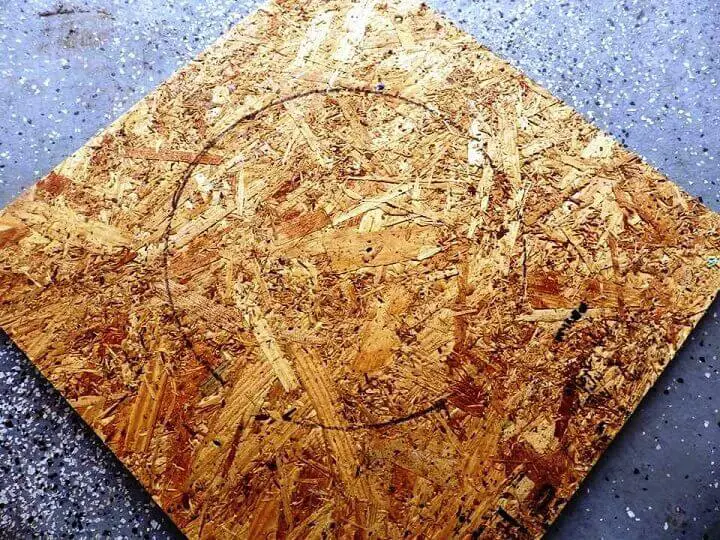
- 4 – 4×4 supports about 16-inches long to serve as the 4 corner supports for the plywood platform.
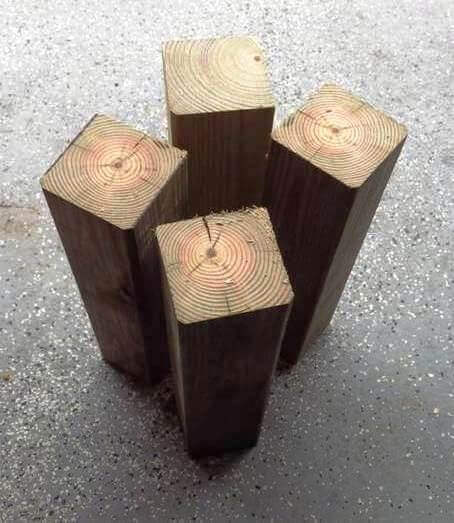
Measure the length determined by the height of your bucket and make sure that the bucket can fit underneath the platform and adjust accordingly. A small step can be added in front or pushed to the side to allow kids to reach the seat.
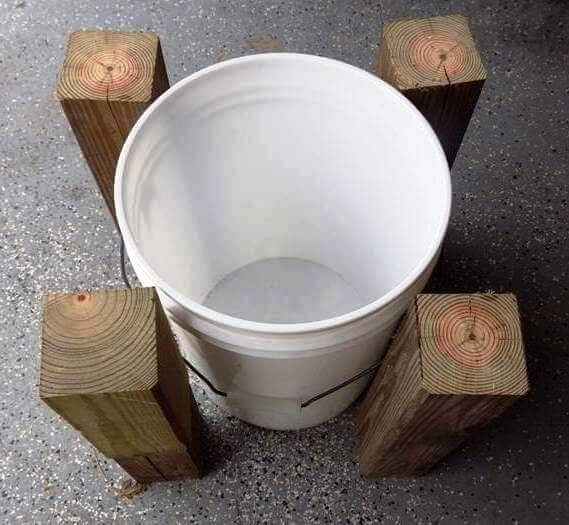
- 4 – 1×4 slats of wood 18-inches long and screwed together to make a box to fit over the top of the toilet seat.
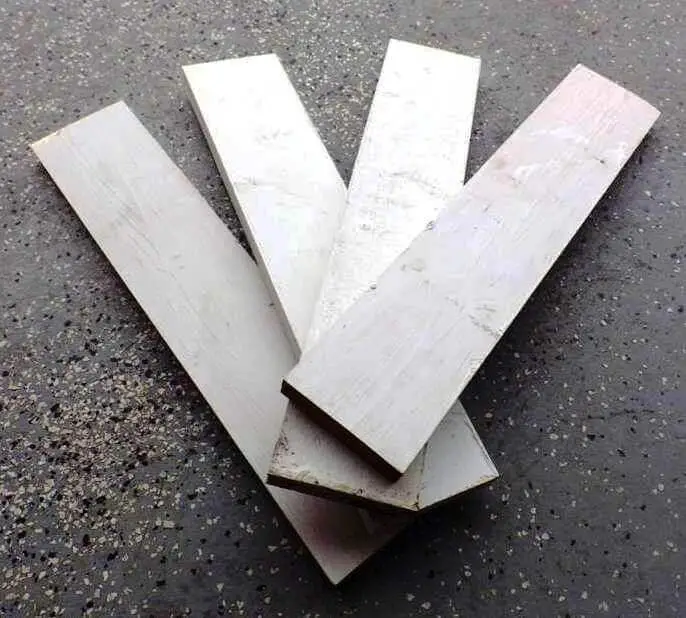
- An 18-inch square sheet of thin plywood that is screwed to the top of the box to create a cover.
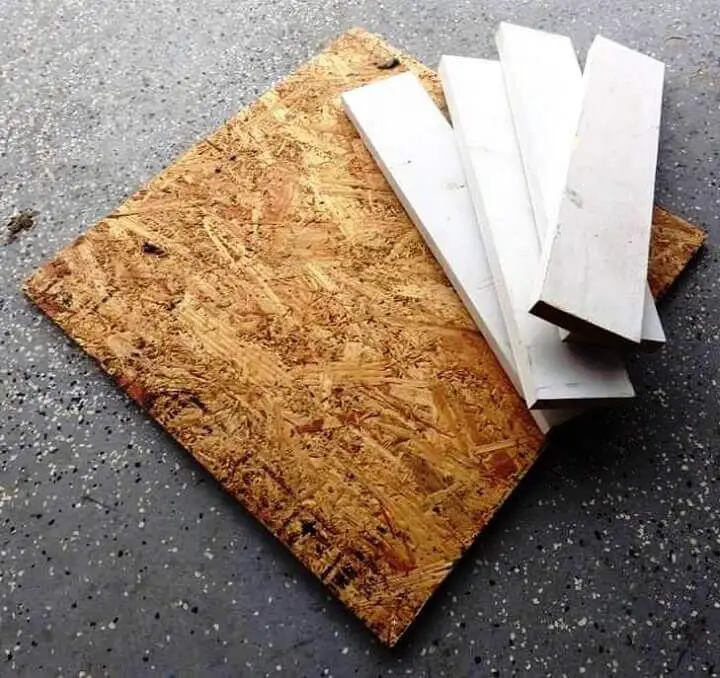
- 2 hinges for the cover box
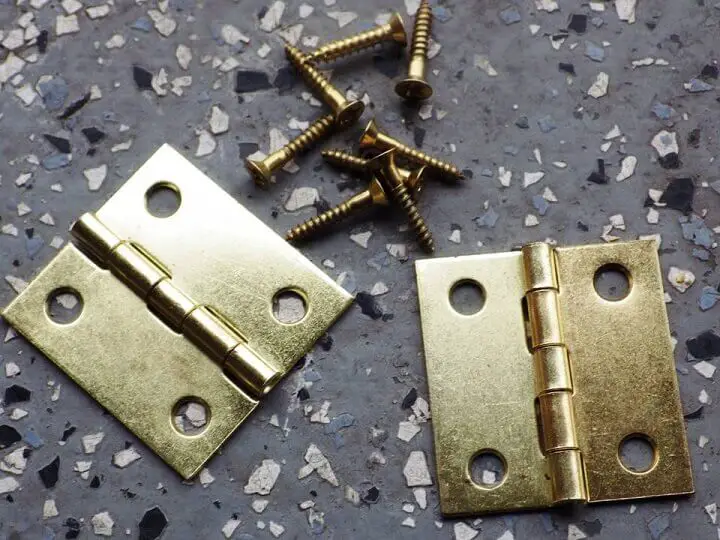
- Optional cover panels around the base of the toilet
- A quart of enamel white paint for the wood around the base
- 1 5-gallon bucket with lid

- A small 10 to 11-inch long toilet seat
- Assorted wood screws
- A compost bucket or container and small scoop or shovel
- Compost – preferably sawdust, peat moss or coconut fibers
Assembly:
1. Attach the 4×4 supports to each corner of the top platform.
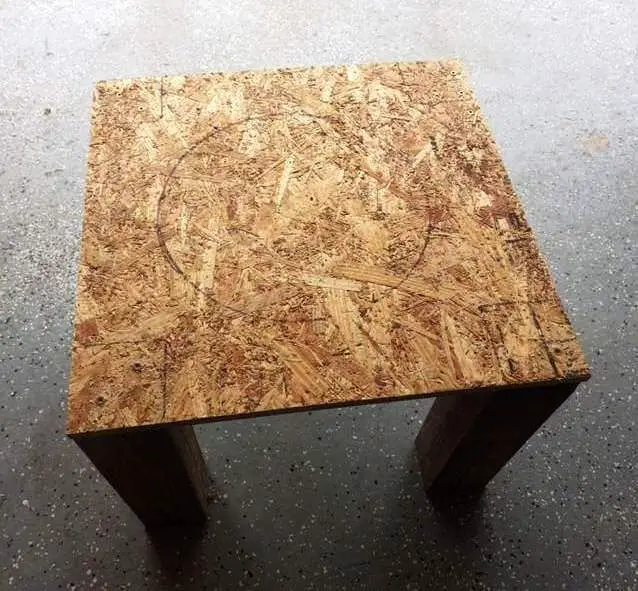
2. Place the 5-gallon bucket on the center of the top and scribe a circle around the rim of the bucket.
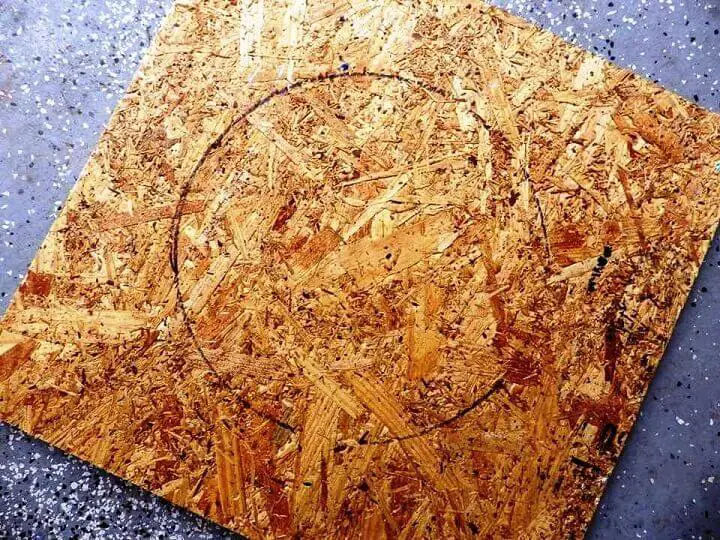
3. Cut the hole along the scribed circle using a jigsaw.

4. Place the bucket underneath to check for fit and alignment.

5. Screw together the box sides for the cover lid.
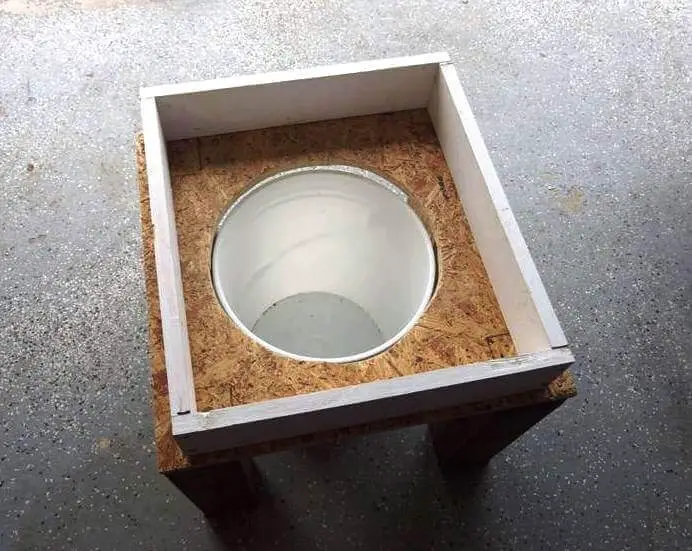
6. Attach the wood sheet to the cover lid sides.

7. Attach the toilet seat so it fits evenly over the hole.
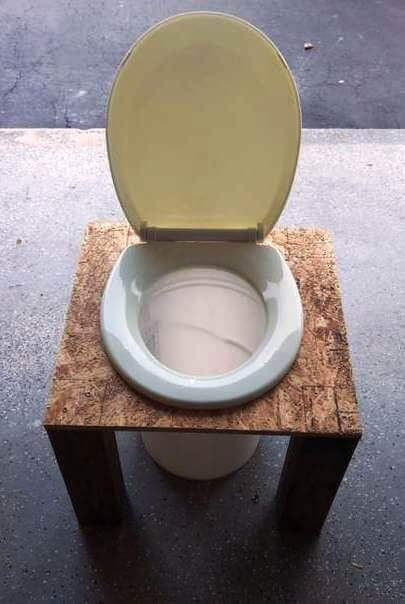
8. Attach hinges to the cover box and attach to the top platform so it clears and covers the toilet seat.
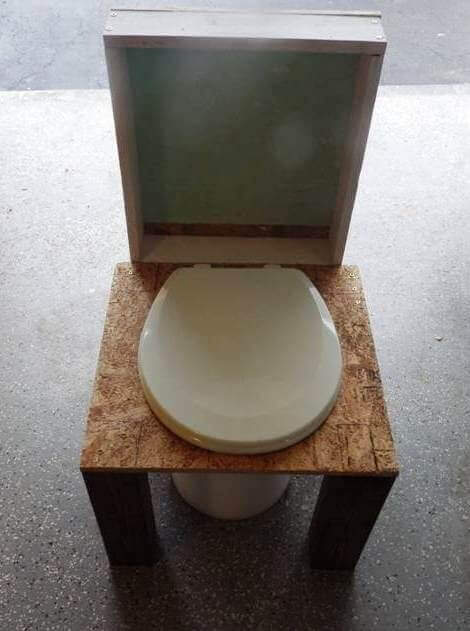
9. Double check and make sure the lid can open clearly into the cover.
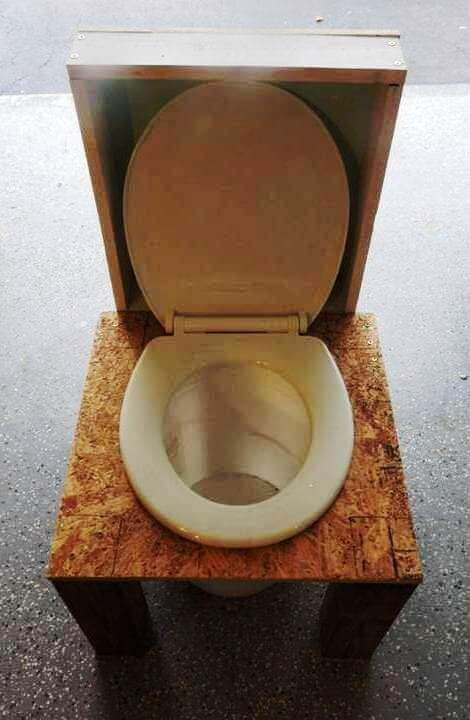
- As an option, you can cover the sides of the platform with plywood, but make sure the front is easily removable or on hinges so you can easily access and remove the bucket.
- Paint if you choose.
- Have a scented candle next to the toilet for those who are a bit squeamish.
Final Thoughts
Periodically clean any buckets from a composting toilet with soap and water. Do not use bleach. Any residual bleach will compromise future composting action. Always rinse the buckets well and either dry them or let them dry before refilling and using.
Use a stick or stake inserted into your compost heap to mark the date of your last deposit into the heap before waiting the full year for the human waste to sufficiently and safely compost. Turn the heap with a shovel from time to time, but don’t use it in the garden until a full year of composting has passed.
When possible, urinate outside or separately from the compost toilet. Some urination is inevitable with any bowel movement, but urine typically causes most of the problems in a composting toilet. If that happens, either dump the buckets more frequently or improvise a urine diverter.
If you are not in a position or location to dump your composting toilet into a compost heap, an alternative is to bury it deep in a hole in the ground. This is much the same as the outhouse concept. If you have nowhere to dump your compost, a composting toilet it may not be an option for you.
Like this post? Don't Forget to Pin It On Pinterest!
You May Also Like:



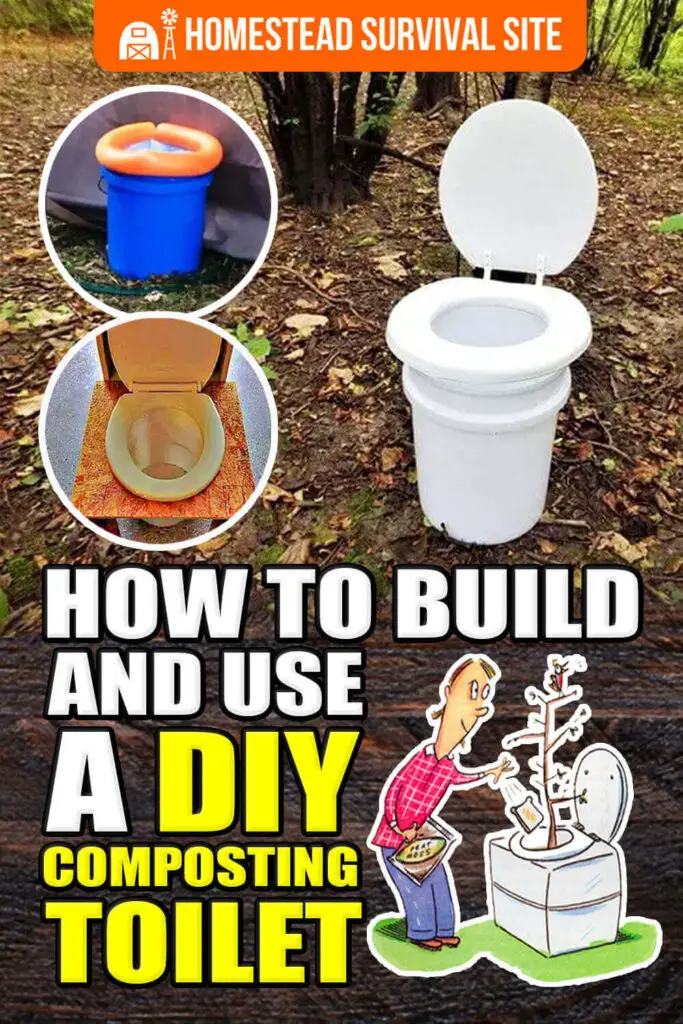








you could use cat litter (especially if you have cats) as an alternative but buy plant-based litter made from grains, paper, or wood pellets.
But that becomes moot when the SHTF doesn’t it… And good luck in that case trying to use grains, paper or wood pellets after the collapse. Because there won’t be any after a very short time.